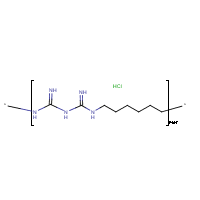Polihexanide
Agent Name
Polihexanide
Alternative Name
PHMB
CAS Number
32289-58-0
Formula
(C8-H17-N5.Cl-H)mult-
Major Category
Other Uses

Synonyms
PHMB; Polymeric biguanide polihexanide; Cosmoquil CQ; PP 073; Polihexanido [INN-Spanish]; Polihexanidum [INN-Latin]; Poly(hexamethylenebiguanide hydrochloride); Poly(iminocarbonimidoyliminocarbonimidoylimino-1,6-hexanediyl), hydrochloride; Poly(iminoimidocarbonyliminoimidocarbonyliminohexamethylene) hydrochloride; Vantocil IB; Vantocil TG; Poly(iminoimidocarbonyliminoimidocarbonylimino hexamethylene monohydrochloride); [ChemIDplus]
Category
Biocides/Disinfectants
Description
Light yellow liquid; [Reference #1] Technical grade (>94.2%): Off-white to light yellow solid with a strong ammoniacal odor; Generally supplied as an aqueous solution (20% PHMB); [ECHA]
Sources/Uses
A polymer used as a biocide in personal hygiene products, contact lens solutions, industrial disinfectants, textiles, and cosmetics; [Merck Index] Used as fungicide, algicide, and sanitizer for swimming pools, preservative for cut flowers, materials preservative (resins, industrial chemicals, textiles, non-food contact paper products, leather, animal hides, and aqueous adhesives), bacteriostat in industrial processes and water systems (drilling muds, packer fluids, and oil field injection water), and disinfectant for hard surfaces (for food and various public health applications); [Reference #1]
Comments
Causes minimal to no irritation to skin of rabbits; Severely irritating to corrosive to rabbit eyes; A moderate to strong skin sensitizer in guinea pigs above induction concentration of 1.2%; A rare skin sensitizer in humans under conditions of current consumer uses; 28-day inhalation studies of rats produced severe respiratory tract irritation, pneumonitis, bronchitis, methemoglobinemia, and effects to thymus at doses above 0.25 mg/m3; No evidence of mutagenicity, teratogenicity, or developmental toxicity; Some evidence of carcinogenicity in experimental animals; “No significant toxicity is induced by PHMB by oral route or by dermal route at doses relevant for classification.” [ECHA] Causes other gastrointestinal and liver changes and weight loss in 7-day oral study of mice; [RTECS] No evidence of danger to the fetus following in utero exposure or by exposure of adults; [Reference #1]
Reference Link #1
Biomedical References
Exposure Assessment
Vapor Pressure
3.08E-09 mm Hg
Lethal Concentration
LC50 (rat) = 30 mg/m3
Adverse Effects
Skin Sensitizer
Yes
Methemoglobinemia
MetHgb is secondary toxic effect
Diseases, Processes, and Activities Linked to This Agent
Diseases
Occupational diseases associated with exposure to this agent:
Processes
Industrial Processes with risk of exposure: